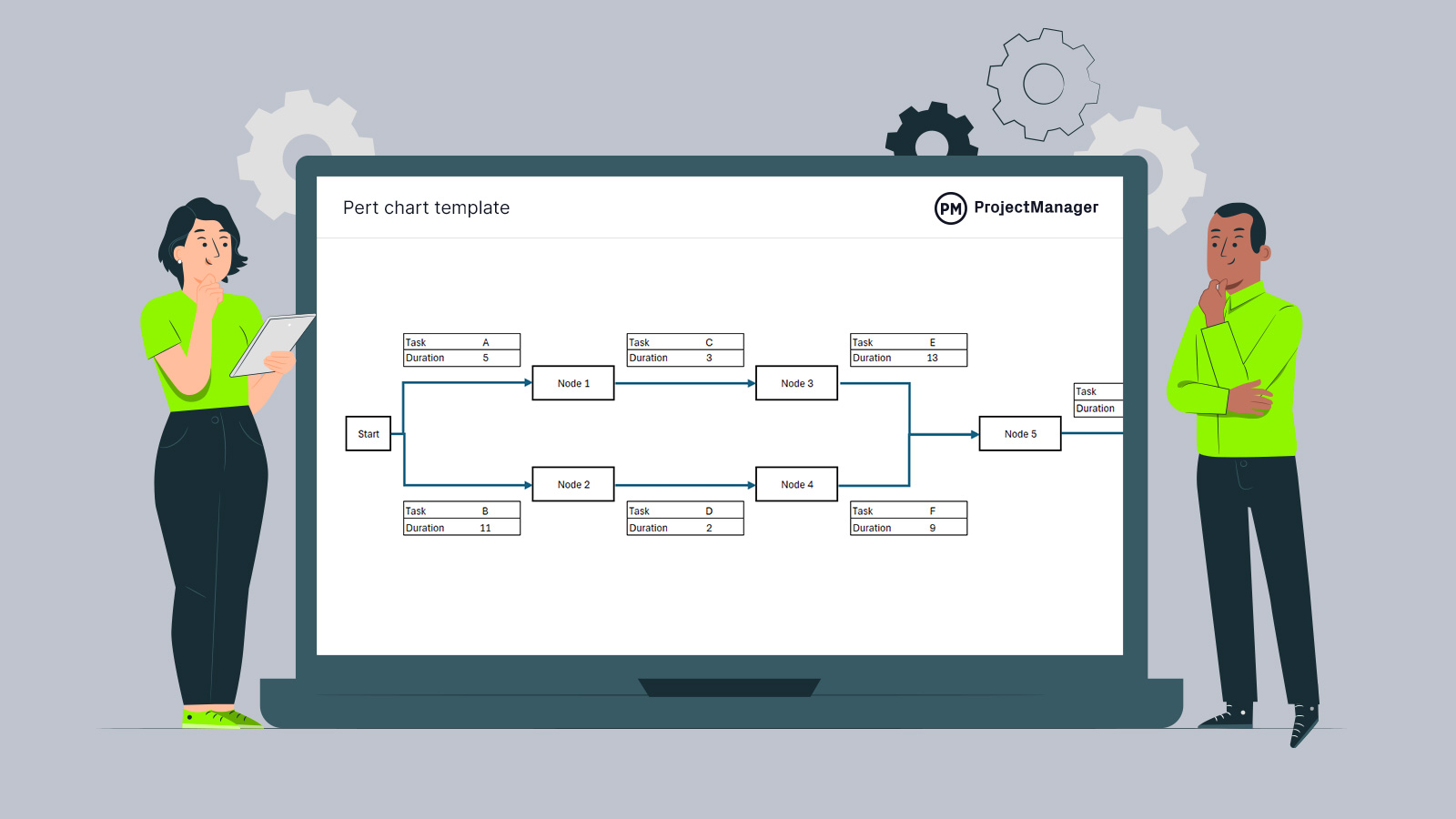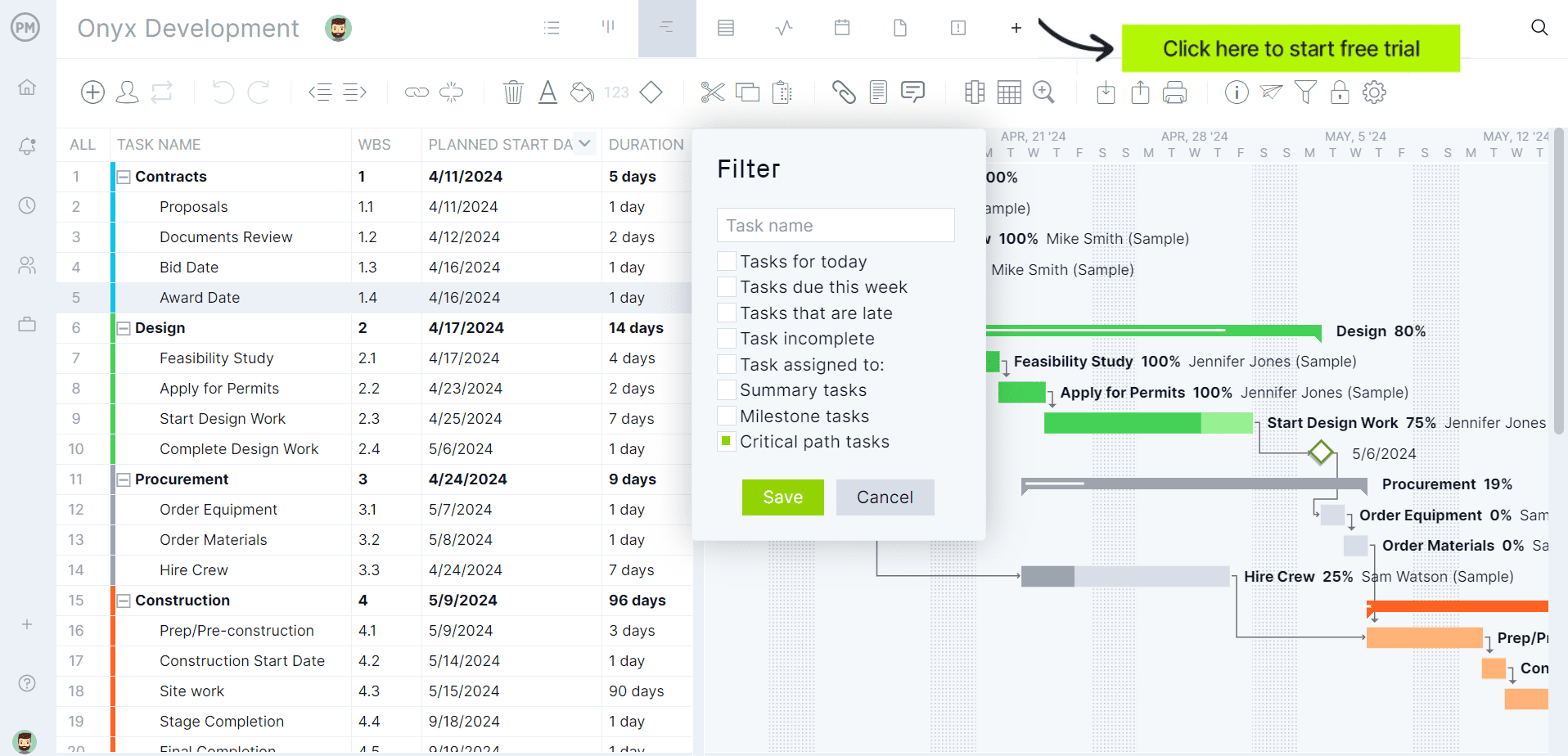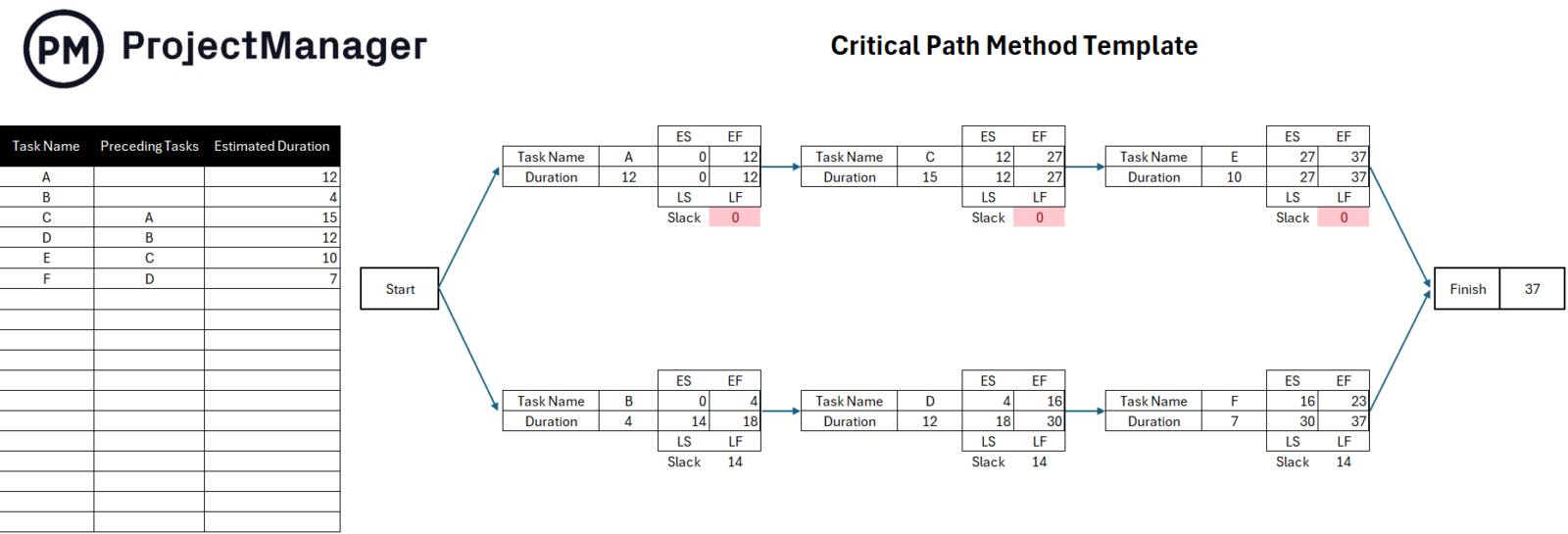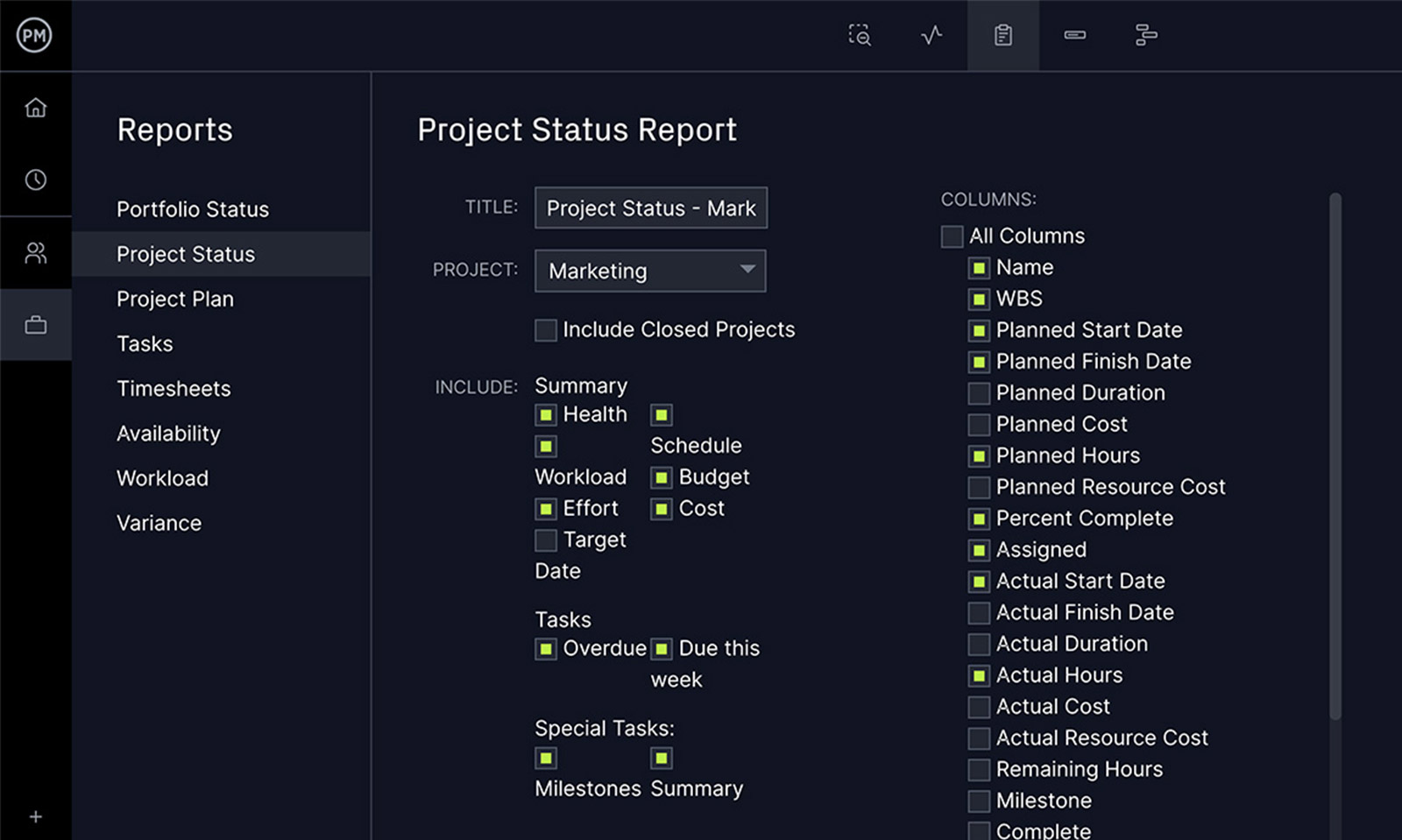Project Evaluation and Review Technique (PERT) and Critical Path Method (CPM) are both useful tools when planning and controlling a project. PERT and CPM are complementary and both are important analytical techniques in project management when managing tasks.
There are differences between PERT and CPM, of course, which is why they work so well together when calculating the time it’ll take to complete tasks in your project. To better understand that relationship, let’s first define both, explore how they differ and see the ways they work together when managing a project.
What Is PERT?
Project managers use PERT as a tool to help them determine how much time it’ll take to complete a project. This is an essential step toward developing an accurate schedule. PERT works on a PERT chart, which maps three-time estimates. One is the optimistic time, or the least amount of time expected for a task to be done.
Next is the pessimistic time, or the maximum amount of time it’ll take to complete a task. Finally, there’s the most likely time, which is a reasonable amount of time to complete the task as long as there are no delays, bottlenecks, etc. Once these estimates have been recorded, the project manager then calculates (optimistic time + 4 x most likely time + pessimistic time) /6.
Then comes the PERT analysis based on the project network diagram that’s made up of arrows showing the direction of the work and nodes, which are circles representing the task. It’s called an activity-on-arrows chart, in which each task or milestone is joined by arrows.

Get your free
PERT Chart Template
Use this free PERT Chart Template for Excel to manage your projects better.
What Is CPM?
CPM is used to determine the earliest possible starting time for each task in the project. It’ll also help a project manager determine the critical tasks and non-critical tasks. This helps when executing the project. If you’re behind schedule, you know which tasks can be skipped without impacting the integrity of the work.
Therefore, the critical path is the longest sequence in a network diagram or the shortest duration for the project to be completed. There are some terms used in CPM just as there are in PERT. These are early start (earliest time a project can be started), late start (latest time to start a project), early finish (earliest completion of a project) and late finish (latest time to complete a project without causing delays).
The CPM is an activities-on-nodes chart and only links one event to the next. As you can see, it can take time to figure out CPM. ProjectManager is project management software with various project views, such as interactive Gantt charts, which filter for the critical path. There are no calculations necessary. It’s all done instantly. Then you can set a baseline to track your planned effort against your actual effort to stay on schedule. Get started with ProjectManager today for free.

PERT vs. CPM: Key Differences
While PERT and CPM are both valuable techniques that help project managers schedule and control their projects, there are differences between the two. Knowing these differences when looking at PERT vs. CPM will help you schedule your project more accurately.
The main difference is that PERT is a visual technique. It helps project managers plan, schedule and control tasks, also referred to as activities. CPM is a statistical technique, though it’s also used to plan, schedule and control. However, it uses well-defined tasks to do so.
Another difference is what PERT CPM does. CPM is used to control cost and time, and PERT is a must for controlling time when planning. PERT is also more of a development and research tool. CPM is more often found in construction project management.
PERT and CPM also differ in terms of how they estimate. For example, as we’ve seen above, PERT uses a three-point method to forecast time, while CPM only has one measure for estimating. They also differ in that PERT is used with time is more valuable than the cost in planning. CPM is more about finding a reasonable time estimate for projects.
You can see that PERT and CPM are different in that PERT is used trying to predict the time of tasks. CPM is used once those tasks are predictable. Also, CPM separates critical and non-critical tasks while PERT doesn’t make a distinction between the two.
Free PERT Chart Template
If you’re ready to start using PERT, download our free PERT chart template for Excel. It will help you perform a PERT analysis in less time. The formulas are baked in, and the diagram is made—all you need to do is input your project values.

Free Critical Path Method (CPM) Template
This free critical path method template allows you to list down your tasks and map them using a network diagram that’s designed to help you use the CPM formula to estimate the total duration of your projects and identify the critical path by calculating which activities have no slack.

Using PERT and CPM in Project Management
As mentioned, PERT and CPM are staples of project management planning and controlling. This is critical as project management is all about controlling the time and cost of the project. Project managers use both PERT and CPM to break up large, complex projects into smaller tasks to minimize time and cost.
PERT and CPM are used as a means to make projects more effective and efficient. When managing projects, PERT and CPM helps project managers know how long the project and individual tasks will take. It helps them determine the best start and end dates for those tasks. They can also see which are critical to the success of the project and which are not. Also, they can find out how long they can delay non-critical tasks and still remain on schedule.
Both PERT and CPM have distinct uses in project planning and controlling. They’re estimating tools and as such key to creating a project schedule, which is an essential part of project management. When used together, they provide a more conservative forecast of a project’s schedule, but also costs and resources as they reveal a more conservative timeframe for those tasks.
PERT/CPM Chart Example
The first part of doing a PERT CPM is identifying the tasks that make up the project. You’ll also want to figure out the immediate predecessor for each and any task dependencies there might be. Then you’ll want to estimate the duration of each task. The time you forecast is noted over the arrows. In our example, that’s weeks. You can use days, weeks or months.
After you’ve made the estimates for your tasks, then you can begin building the PERT chart starting on the left and moving toward the right. The farthest left is the beginning and the farthest right is the end of the project. The arrows connect the nodes or milestones and indicate the time spend on tasks.

Benefits of Using PERT and CPM
It should be clear what the advantages of using PERT CPM are. PERT is an ideal tool for scheduling tasks on projects and helps you figure out the critical path. Together they help you determine the schedule so you can coordinate the work of your project team.
Make Timely Decisions
Project managers can also use PERT and CPM to make timely decisions when executing the project. These choices help prevent delays and deliver projects on time. PERT is great for what-if scenarios and the critical path helps to identify different uncertainties in the project.
Using both PERT and CPM will promote the coordination of departments involved in the project. It facilitates decision-making for cross-functional teams with ample data that helps with project management. You can also analyze all tasks to see if the project will be completed within the budget.
Related: Free Construction Estimate Template for Excel
Long-Term Project Planning With Milestones
While there’s a hurdle to understanding CPM and doing the calculations is time-consuming, once cleared there are many advantages. CPM helps with outlining long-term planning while identifying critical tasks, making it easier to plan, schedule and control the project. This leads to greater productivity and better resource management.
PERT, on the other hand, identifies milestones and the sequence of tasks in the project. It’s a visual tool, which helps everyone on the project team understand it. PERT charts should be updated throughout the life cycle of the project to ensure its benefits.
ProjectManager Combines PERT and CPM
To get the benefits of PERT and CPM without having to spend time on calculations, you need project management software. But not all project management software is the same. ProjectManager is online project management software that has Gantt charts that can filter for the critical path and show you what is critical and non-critical when managing your project.
Track Progress in Real Time
Projects change and to stay on top of those changes you need to constantly review and revise your PERT and CPM. Our software is online, which means the data you see is live. Our real-time dashboards give you a high-level view of the project. There’s no setup required and our dashboard is configured for you, unlike lightweight tools. You can toggle over any time and capture the time spent on tasks, workload, costs and more to keep your project running smoothly.

Get In-Depth Reporting
Estimates are best guesses, but when you’re managing a project, accuracy is key. Our real-time reports are easy to generate with only a couple of keystrokes. Each is customizable so you can filter to see only the real-time data you want, whether it’s a status report, task and time progress or one of the many others. You can make better decisions with detailed, real-time data. Then share the reports with stakeholders to keep them updated.

Gantt charts are better than PERT charts, not only because ours filters for the critical path, but they help you manage tasks, subtasks, link dependencies to avoid delays, manage resources and so much more. Files can be shared, tasks commented on and anyone tagged to bring them in, which connects your team across departments or timezones. Go beyond PERT and CPM with our robust software.
ProjectManager is award-winning software that helps you plan, manage and track projects. Our tool empowers teams with a collaborative platform, multiple project views and more. Join teams at Avis, Nestle and Seimens. Get started with ProjectManager today for free.


